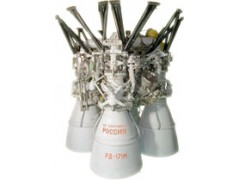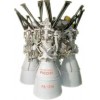RD-171 engines for first stage of “Zenit” launch-vehicle
The development of RD-170 and RD-171 engines for first stages of the “Energia” and “Zenit” launch-vehicles correspondlingly was began in 1976. Their development became qualitatively new step in creation of powerful liquid propellant rocket engines. Most powerful in the world four-chamber LPRE has the best level of parameters and characteristics for engines of the given class, operates on ecological clean propellant components: liquid oxygen and kerosene. RD-170 engine for the “Energia” launch-vehicle is intended for reusable operation and is certificated for 10-multiple use. One of the engines was tested at a fire bench up to 20 times. The engine is characterized by high operational reliability, can be repaired and controlled, has a large margin on life operation (not less 5). The engine thrust vector control is carried out with creating the chambers unique bellows gimball joint, operated in a zone of a high-temperature gas flow. The engines have passed about 900 fire tests with common running time more than 100000 sec. The maiden launch of the “Zenit” launch-vehicle with RD-171 engine was carried out in April, 1985. In 1987 and 1988 the launches of “Energia” launch-vehicles with RD-170 engines were conducted. Since 1999 the operation of RD-171 engines is prolonged in a structure of “Zenit 3SL” launch-vehicle under the “Sea Launch” program.
Main parameters of the RD-170/171 engines family
Liquid propellant rocket engine with afterburning of oxidizer-rich gas
Propellant liquid oxygen + kerosene
Engine modifications
RD-170
RD-171
RD-171M
Thrust, sea level / vacuum, tf
740 / 806
740 / 806
740 / 806
Specific impulse, sea level / vacuum, sec
309 / 337
309 / 337
309,5 / 337,2
Combustion chamber pressure, kgf/cm2
250
250
250
Weight, dry / filled, kg
9750 / 10750
9500 / 10500
9300 / 10300
Overall dimensions, height / diameter, mm
4000 / 3800
4015 / 3565
4015 / 3565
Period of development
1976-1988
1976 – 1986
1992 – 1996
2003 - 2004
Purpose
“Energia”
“Energia”
“Energia”
The base RD-170/171 engine was designed in 1976-1986. In 1992-1996 works on forced version of RD-171 engine (28 engines were tested to 1996) were conducted. 5500 sec of running time was achieved at 6 engines of an improved design, and the running time at one engine was 1590 sec.
The activities on RD-171 engine modernization for use in “Sea Launch” program were proceeded in 2003-2004. The certification of the RD-171M engine is completed by July 5, 2004 - 8 tests by duration of 1093,6 sec were conducted on the certified engine, and last test (in excess of the plan) - on 105 % thrust mode was conducted. The first serial production engine RD-171M was delivered to Ukraine March 25, 2004 after acceptance-check test at duration of 140 sec. These engines will be used and for launches of “Zenit” launch-vehicle from Baikonur.
The serial production of the RD-171M engine is conducting at plant of NPO Energomash in Khimky.
Operation of RD-171M engines has conducting in “Land Launch”, “Sea Launch” and Federal Space program of Russia.
NPO Energomash's Information on Results of Investigation of RD171M Engine Acceptance Hot Fire Tests Failure
December 25, 2009 a failure of RD171M engine occurred at OAO NPO Energomash's test bench during the engine acceptance hot fire tests with destruction of the engine hardware and some test bench systems. Commission, consisting of experts of different NPO Energomash's departments, reviewed the results of telemetry data processing and hardware condition analysis, results of design evaluation and results of specially organized and conducted experimental investigations and decided the following:
1. The engine failure at its operation in nominal thrust mode has occurred as a result of ignition at 17.6 sec. in the gas cavity downstream of the MTU turbine in the area of connection of turbine exhaust manifold with gas duct of one of the chambers (Chamber #2). Ignition development led to destruction of the engine gas duct behind the turbine, explosion and fire at 18.2 sec.
2. Initiation of ignition has happened in consequence of a foreign object entering into gas cavity in the process of the engine fabrication; the foreign object could not be detected by standard inspection and control procedures.
3. Organic nature of foreign object (substance) entered into the gas duct in the process of the work on the engine "gas ducts" sub-assembly was defined as the most probable.
4. The determined cause of RD171M engine failure doesn't require corrective actions for engines RD171M, RD180 and RD191 underwent acceptance hot fire tests.
5. The commission developed and recommended a package of corrective measures as to prevent foreign objects (substances) entering into internal cavities of all engines and to introduce additional engines gas ducts inspection procedure at final phases of the engines assembly as well.
RD-171M





